Related Research Articles

Fayette County is a county in the Commonwealth of Pennsylvania. It is located in southwestern Pennsylvania, adjacent to Maryland and West Virginia. As of the 2020 census, the population was 128,804. Its county seat is Uniontown. The county was created on September 26, 1783, from part of Westmoreland County and named after the Marquis de Lafayette. The county is part of the Southwest Pennsylvania region of the state.

Rainsburg is a borough in Bedford County, Pennsylvania, United States. The population was 141 at the 2020 census.
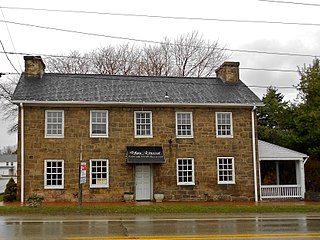
Hopwood is a census-designated place (CDP) in Fayette County, Pennsylvania, United States. The population was 2,090 at the 2010 census, up from 2,006 at the 2000 census. It is located in North Union and South Union townships. The village was named after John Hopwood.

Uniontown is the largest city in and the county seat of Fayette County, Pennsylvania, United States, 46 miles (74 km) southeast of Pittsburgh. The population was 9,984 at the 2020 census. It is part of the Pittsburgh metropolitan area.
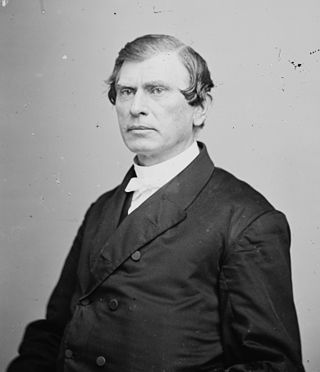
Matthew Simpson was an American bishop of the Methodist Episcopal Church, elected in 1852 and based mainly in Philadelphia. During the Reconstruction Era after the Civil War, most evangelical denominations in the North, especially the Methodists, were initially strong supporters of radical policies that favored the Freedmen and distrusted the Southern whites. However, by the late 1860s in border state conferences, the MEC North moved well away from their work with the Freedmen's Bureau and often sided with the grievances of Southern white members. Bishop Simpson played a leading role in mobilizing the Northern Methodists for the cause. His biographer calls him the "High Priest of the Radical Republicans."

Rev. Henry Gerhard Appenzeller was a Methodist missionary. He and four other missionaries, including Horace N. Allen, Horace G. Underwood, William B. Scranton, and Mary F. Scranton introduced Protestant Christianity to Korea from 1885 to 1902. He was known for his three major contributions to Korea: the Paichai College Hall, the First Methodist Episcopal Church of Seoul, and the translated New Testament.

Waitman Thomas Willey was an American lawyer and politician from Morgantown, West Virginia. One of the founders of the state of West Virginia during the American Civil War, he served in the United States Senate representing first the Restored Government of Virginia and became one of the new state of West Virginia's first two senators. He is one of only two people in U.S. History to represent more than one state in the U.S. Senate, the other being James Shields.
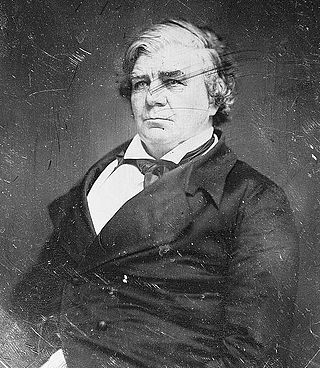
Daniel Sturgeon was an American physician, banker and Democratic party politician from Uniontown, Pennsylvania. He served in both houses of the state legislature and represented Pennsylvania in the United States Senate.
The Middle Atlantic League was a lower-level circuit in American minor league baseball that played during the second quarter of the 20th century.

Samuel Sloan was a Philadelphia-based architect and best-selling author of architecture books in the mid-19th century. He specialized in Italianate villas and country houses, churches, and institutional buildings. His most famous building—the octagonal mansion "Longwood" in Natchez, Mississippi—is unfinished; construction was abandoned during the American Civil War.
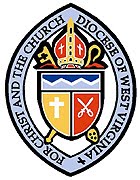
The Episcopal Diocese of West Virginia is a diocese of the Episcopal Church in the United States of America (TEC). It encompasses all 55 counties of West Virginia. The diocese has 66 congregations, including 38 parishes, 26 missions, and 2 other churches. The diocese is headquartered in Charleston and led by The Rt. Rev. Matthew Davis Cowden who was consecrated as bishop coadjutor in March, 2022 and became bishop diocesan in October, 2022.

Chester Dorman Hubbard was a two-term U.S. Representative from West Virginia, who previously served in the Virginia General Assembly and Virginia Secession Convention of 1861 before the American Civil War and who helped found the state of West Virginia.

Francis G. Waters, D.D., LL.D., was a Methodist minister from Baltimore, Maryland, U.S., and a founding member of the Methodist Protestant Church. He was elected as the first president of the church on November 2, 1830, and presided over the general convention, in which the church's constitution was adopted. From 1849 to 1853 Waters served as the second principal of Baltimore City College. He was selected as president of Madison College in Uniontown, Pennsylvania, in summer 1853 but left the institution later that fall because of family illness. He also served twice as the Principal of Washington College in Chestertown, Maryland.
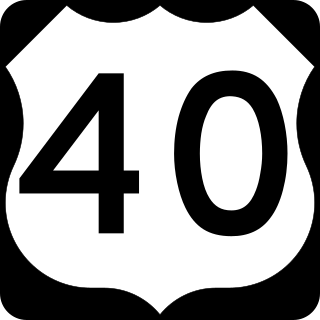
U.S. Route 40 enters Pennsylvania at West Alexander. It closely parallels Interstate 70 (I-70) from West Virginia until it reaches Washington, where it follows Jefferson Avenue and Maiden Street. In Washington, US 40 passes to the south of Washington & Jefferson College. Following Maiden Street out of town, the road turns southeast toward the town of California. A short limited access highway in California and West Brownsville provides an approach to the Lane Bane Bridge across the Monongahela River. From here, the road continues southeast to Uniontown.
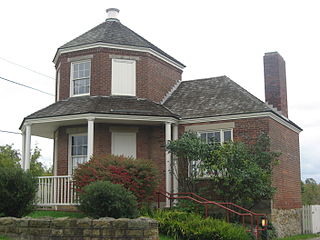
The Searights Tollhouse of the National Road is a historic toll house on United States Route 40, the former route of the historic National Road, north of Uniontown, Pennsylvania. Built in 1835, it is one of two surviving tollhouses built by the state of Pennsylvania to collect tolls along the portion of the road that passed through that state. It has been restored by the state and is now maintained by the local historical society. It was declared a National Historic Landmark in 1964.

Johnsville is an unincorporated community in Frederick County, Maryland, United States. It is located approximately halfway between Libertytown and Union Bridge along Maryland Route 75. The Kitterman-Buckey Farm was listed on the National Register of Historic Places in 2005.
The Allegheny Wesleyan Methodist Connection (AWMC), originally the Wesleyan Methodist Church (Allegheny Conference), and also known as the Wesleyan Methodist Church (WMC), is a Methodist denomination within the conservative holiness movement. It is primarily based in the United States, with missions in Peru, Ghana, and Haiti. The Allegheny Wesleyan Methodist Connection is currently led by Rev. David Blowers (President) and Rev. Joseph Smith (Vice President).
Madison College may refer to:
Alice Rebecca Appenzeller was the first American and first Caucasian born in Korea. Daughter of the Methodist missionary Rev. Henry Appenzeller who was among the first to introduce Protestantism to Korea, she spent her early years in Seoul until returning to the United States in 1902. There she pursued her education, first at the Shippen School for Girls. She later graduated from Wellesley College, after which she returned to the Shippen School to teach. She was appointed by the Methodist Church as a missionary teacher at Ewha College in Seoul in 1915 and became president of the college in October 1922.
Aubrey Franklin Hess was a progressive American theologian and educator. Born on a mountaintop farm in Virginia, Hess without formal theological training was ordained in the Methodist Protestant church in 1896 and immediately served two small congregations in West Virginia. Later, after completing his formal theological and university education, Hess served as president of the Methodist Protestant institutions of West Lafayette College, Ohio and Adrian College, Michigan.
References
- ↑ Reynolds, G.T. (1902). "Madison College". In Haskins, Charles Homer; Hull, William Isaac (eds.). A History of Higher Education in Pennsylvania. Government Printing Office. pp. 155–7.
Madison College Pennsylvania.
- ↑ Daniel, W. Harrison (January 1979). "Madison College, 1851-1858: A Methodist Protestant School" (PDF). Methodist History. 17 (2): 91. Retrieved July 16, 2023.
- ↑ "A Worthy Example" (PDF). Raftsman's Journal (Clearfield, PA). February 23, 1870. Retrieved July 22, 2023.
- ↑ Cummings, A.W. (1886). The Early Schools of Methodism. New York: Phillips & Hunt. p. 62. Retrieved July 16, 2023.
- ↑ Hopwood, Robert F. (1938). History of the Methodist Episcopal Church of Uniontown, Pa. Uniontown, Pa.: Robert F. Hopwood. p. 71. Retrieved July 15, 2023.
- ↑ Cummings, A.W. (1886). The Early Schools of Methodism. New York: Phillips & Hunt. p. 62. Retrieved July 16, 2023.
- ↑ Hopwood, Robert F. (1938). History of the Methodist Episcopal Church of Uniontown, Pa. Uniontown, Pa.: Robert F. Hopwood. pp. 22, 24, 96. Retrieved July 15, 2023.
- ↑ "A Leading Man Gone" (PDF). Wheeling (WV) Daily Intelligencer. January 15, 1889. Retrieved July 23, 2023.
- ↑ Oberholtzer, Ellis Paxson (1912). Philadelphia A History of the City and its People A Record of 225 Years (Volume 4). S.J. Clarke Publishing. pp. 5–9.
- ↑ "Thomas Brownfield Searight". House Archives. Archives of the Pennsylvania House of Representatives. Retrieved July 20, 2023.
- ↑ "Thomas Brownfield Searight". Senate Library. Library of the Senate of Pennsylvania. Retrieved July 20, 2023.
- ↑ "The Pittsburg Candidate" (PDF). Pittsburg Dispatch. July 3, 1890. Retrieved July 22, 2023.
- ↑ "James F. Dayton Dead" (PDF). Wheeling (WV) Register. September 12, 1895. Retrieved July 23, 2023.
- ↑ "Tribute to Two Good Men" (PDF). Pittsburg Dispatch. November 16, 1890. Retrieved July 22, 2023.
- ↑ Addresses Delivered at the Opening of Madison College, Uniontown, PA, September 1, 1851. Baltimore: Methodist Protestant Book Rooms. 1851. p. 6. Retrieved July 16, 2023.
- ↑ Circular of Madison College, Uniontown, Fayette County, Pennsylvania (March 1, 1852 ed.). Baltimore: Sherwood & Co. 1852. Retrieved July 15, 2023.
- ↑ Daniel, W. Harrison (January 1979). "Madison College, 1851-1858: A Methodist Protestant School" (PDF). Methodist History. 17 (2): 99. Retrieved July 16, 2023.
- ↑ Daniel, W. Harrison (January 1979). "Madison College, 1851-1858: A Methodist Protestant School" (PDF). Methodist History. 17 (2): 102–103. Retrieved July 16, 2023.
- ↑ Daniel, W. Harrison (January 1979). "Madison College, 1851-1858: A Methodist Protestant School" (PDF). Methodist History. 17 (2): 103–104. Retrieved July 16, 2023.
- ↑ "Annual Conference of the M.P. Church" (PDF). Daily Pittsburgh Gazette. 7 September 1857. Retrieved 31 October 2023.
- ↑ "[A Branch of the School]" (PDF). Wheeling (WV) Daily Register. 14 December 1866. Retrieved 23 July 2023.
- ↑ "[The Uniontown, Fayette county]" (PDF). Lancaster Intelligencer. 12 December 1866. Retrieved 31 October 2023.
- ↑ "[Gilbert Collegiate Institute]" (PDF). New Dominion (Morgantown, WV). 4 June 1887. Retrieved 22 July 2023.